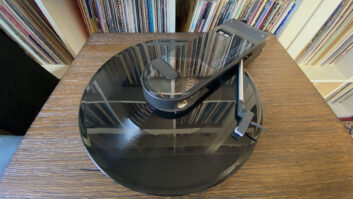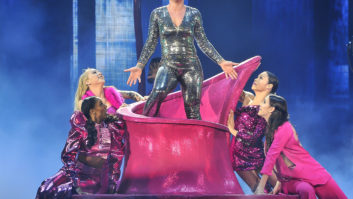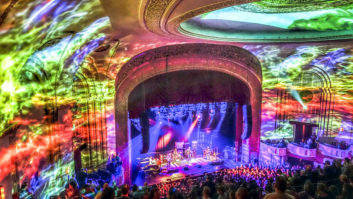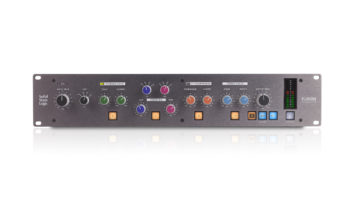There are rock bands, and then there is the Rolling Stones. Who else could sell out arenas and stadiums night after night (with $450 tickets, no less), headline over the likes of Mötley Crüe and Metallica, and support a production that piggybacks 130 trucks across North America? After all the hype leading up to November’s A Bigger Bang tour stop at San Francisco’s SBC Park (and with our pricey tickets in hand), we expected something really over-the-top, and we were not disappointed. Under a full moon, before a sold-out crowd, the 62-year-old Mick Jagger and crew proved — from the opening crunch of “Start Me Up” that brought 40,000 screaming fans to their feet to the showstopping “Satisfaction” encore — that after all these years, the Stones still rock the house.
THE TEAM BEHIND THE TOUR
The tour is a major haul: The North American leg kicked off in August at Boston’s Fenway Park, and there will be more than 35 more stops before the production heads to Mexico, South America, the Far East, New Zealand, Australia and finally Europe this summer. Opening acts rotate throughout the tour and are as diverse as Merle Haggard, Alanis Morissette and the Black Eyed Peas. The energy of the band’s performance is matched in scope by the larger-than-life stage production, featuring a 60-foot video wall, two multistory towers housing dozens of lucky fans and. of course, the world’s biggest inflatable lips and tongue. Sound for the tour is provided by Clair Bros.; the audio crew includes Mike Adams and J. Summers on monitors, and 27-year veteran front-of-house engineer Dave Natale, who’s enjoying his first gig with the Stones.
After exhaustive planning and practice, the show comes across as effortless and spontaneous. The band and crew spent six weeks in heavy tour prep, rehearsing eight hours a day, six nights a week, at a junior college in Toronto. “All our catering was set up in the cafeteria, and the band set up in the gym with lighting, drape and heavy black carpeting. It sounded great,” says Natale. “We sat there for six weeks and just rehearsed. I was in a classroom down the hall with my console and four Clair Bros. S-4 cabinets.” Meanwhile, at the Toronto airport, the production staff rented a hangar in which they could practice building the indoor and outdoor stages at the same time. “It was a big hangar, needless to say,” he says with a laugh.
On a show of this scale, working out the logistics in advance is crucial, says Natale. “You have to figure out the procedure for load-in beforehand because there’s so much going on,” he says. “If you’re slow, you’re going to slow down about fifty other guys who are waiting for you to do your thing so they can do their thing, so it has to be right the first time, every time. There’s no time to figure it out at the gig. But there was plenty of rehearsal time for everyone involved, so it was no big deal and it has all worked out perfectly. We went to Boston, we put it all up and turned the P.A. on and went, ‘Wow.’”
Front-of-house mixer Dave Natale
Photo: Steve Jennings
The three-show-a-week schedule allows for plenty of production time. On stadium days, the crew goes in the day before, starting around 10 a.m., finishing up the P.A. by 6. (The two 60-foot stage towers are built with steel girders and take two days to assemble with multiple 20-ton cranes.) “It’s a pretty good schedule. You want to make sure that if you have problems, you’ll have enough time to fix them,” says Natale, stressing that load-in has been smooth on every date — a result of careful planning by production manager Dale “Opie” Skjerseth, stage managers Anthony Giordano, Seth “Burger” Goldstein and the modular setup. He confesses that A Bigger Bang is a bigger production than any tour he’s worked on, but, “This is the biggest band,” he says.
THE MIX: LESS IS MORE
A Yamaha PM4000 handles 44 inputs from the main stage and a Mackie Onyx 3280 manages the 22 inputs from the B stage, along with main keyboard inputs. (Natale carried a 1604 VLZ up until recently, when a visitor from Mackie convinced him to audition the new board.) Countering the elaborate stage production, the audio mix is a “less is more” approach. “I’ve got one reverb in my rack, but it’s off,” jokes Natale, who also has two dbx 900 racks with Model 903 limiter modules, a Manley Electro Optical Limiter and two Aphex 612 gates, in addition to that Lexicon PCM91 reverb on standby.
But the sparseness of the effects doesn’t mean the production is low-tech: Two Gateway Motion 100 tablet computers run SIA Smaart and control 16 Lake digital P.A. processors, respectively. A couple of Alesis MasterLinks and a Midas XL-88 rackmount mixer round out front of house. Although there are 11 people on the audio crew (see sidebar below), Natale sets up the FOH rig himself. “I have to know it’s all plugged in right and I know it’s right,” he says.
Gear selection was worked out during rehearsals, and Natale was ready to roll with the demands of the band. “We weren’t really sure how big it would get,” he explains. “The thing you want to say to these guys is, ‘Yeah, got it right here,’ rather than, ‘Uh, I can have it for you tomorrow?’ That’s why I had 150-plus microphones — because I had a rough idea of what they wanted to see.” In the end, the band was completely open, and Natale opted for straightforward mics. “[The band] was very cool; [they let me do] whatever,” he says. “Mics are [Shure SM] 57s on almost everything; [SM] 58s on the vocals — regular 58s, that’s about it. They’re a straightforward band.” Other mics include more 57s and 58s on guitars; a Shure Beta 48 headset mic; Electro-Voice RE-20 on bass; Sennheiser 421s on horns; and 57s, Beyer M88, Neumann KM84s and Sennheiser 409s on drums. Other inputs include Radial J48, JPC, JDI and Duplex; and Countryman DIs.
SOUND ONSTAGE
Two monitor positions flank the giant stage. Mike Adams, on stage left, handles the four Stones and bass player Daryl Jones. J. Summers takes care of the three background singers, keyboardist and the four players in the horn section from his stage-right position.
Adams mans a Midas Heritage 4000 and a 3000, with 20 Clair Bros. Lake iOs. Outboard gear used on these monitor mixes includes Avalon 737, Manley ELOP and dbx compressors; Yamaha SPX-990 reverbs; and Eventide H3000s. The band’s in-ear system is a combination of Sennheiser G Series and Shure PSM700s.
Summers’ monitor rig is based around a Midas H3000 and Mackie Onyx 1620, with 20 TC 1128 graphic EQs, a Yamaha SPX-1000 multi-effects, Drawmer DL241 and DS201 noise gates, Empirical Labs Distressor EL-8xs and dbx 160 compressor/limiters.
An army of wedges covers the giant stage, including 110 compact Showco SRM monitors, with six Showco Prism Blue cabinets, all powered by Crown 3600 series amp racks. There are also nine Prism SRM monitor amp racks and CBA I-4B and ML-18 subs.
The P.A. is either huge or gargantuan, depending on whether it’s configured for an indoor or outdoor stage. Like everything on the tour, the technical package is scalable, designed for streamlined execution. “The P.A. is packed up as an arena P.A. system, then there is another truck of stadium gear that they add on to the arena gear, and those trucks only go to stadium gigs,” explains Natale. “So the whole indoor arena package travels together. Anything extra for the stadium is called ‘the stadium package.’” This “kit” includes additional stage cabinets, delays and supplemental wedges for the extended outdoor stage.
“This makes it easy because most of the time we only have to deal with two trucks,” he says. For arena shows, the Clair rig includes 44 i4s, arrayed in front, side and rear arrays, plus 44 i4Bs, 16 S4 Sub Ls and eight P2 frontfills. Outdoor stadium rigs are beefed up with an additional 20 i4s, 20 i4Bs and 24 R4s. QSC PowerLight 9.0 and Crown 3600s power the i4s/i4Bs, while Carver 2.0s power the subs, frontfills and R4 delays.
Natale insists that he hasn’t faced any real complications on this tour. However, he admits that he was a bit wary at first about mixing for the B stage, which rolls 200 feet into the audience — that’s 200 feet down-range of the P.A. — as the band plays a four-song mini-set. “I thought to myself, ‘You want to play where? In front of the P.A.? Okay, I’ll try anything!’” he says. “And we rolled out, and holy shit, it sounded fine! It’s so weird — there’s no feedback, it didn’t get hollow, nothing like you would expect. It’s not natural! But you know, there’s a big delay at 200 feet away. The sound’s still coming out of the P.A system, but with 180 ms of delay, it’s long enough to screw you up!”
Natale says wedges on the B stage keep the band in line. “The backline wedges and amps on the little stage are fairly loud. They just turn it up, blast away and don’t even notice the delay.” Amazingly, there have been no audio problems. “We have done it too many times — indoors, outdoors — it’s really weird,” he says, smiling. In the end, the show really is simple, Natale insists, with characteristic understatement. “It’s just really big.” Big, indeed.
Sarah Jones is Mix’s features editor.
AN AUDIO ARMY
Rolling Stones Sound Crew




